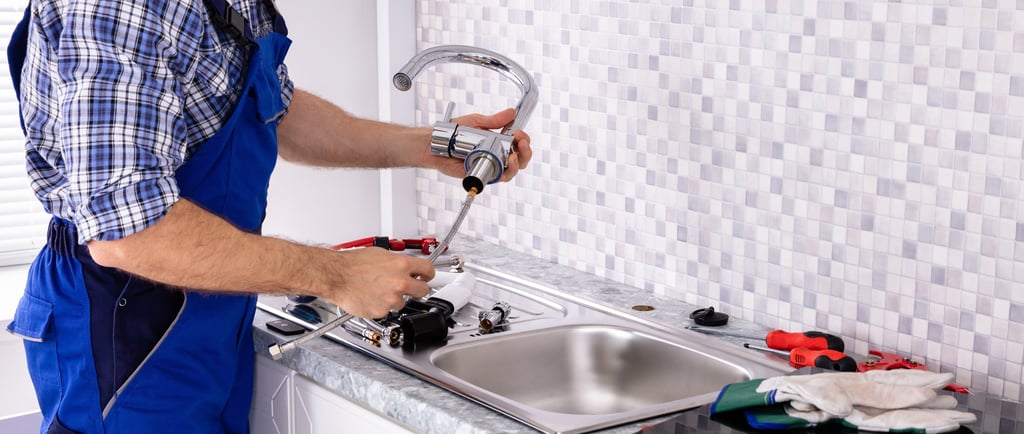Reusing Old Faucets: What’s Safe, What’s Risky, and What’s a Nightmare
FAQSRESIDENTIAL PLUMBING
4/30/20254 min read


If you're replacing a sink or remodeling a bathroom, you might wonder: Can I reuse my old faucet? It seems like an easy way to save money, but not all plumbing parts are built for a second life. Some components wear out, others degrade in ways you can’t see, and a few can lead to serious leaks—or worse, water contamination.
So, before you reinstall that old faucet, let’s break down what’s safe, what’s risky, and what could turn into a plumbing nightmare.
What’s Safe to Reuse?
Some faucet components can be reused with minimal risk, as long as they’re in good condition. Here’s what might be salvageable.
1. The Faucet Body (Sometimes)
The main metal body of a faucet—whether brass, stainless steel, or another metal—can often be reused if it’s in excellent shape. However, if there’s any sign of corrosion, mineral buildup, or rust, it may not be worth keeping.
Check for these:
Pitting or corrosion inside or outside
Hard water deposits that won’t clean off
Any cracks or stress fractures
2. Handles and Decorative Trim
Faucet handles and trim pieces don’t undergo much wear and tear compared to internal parts. If they’re still functional and free of damage, they’re usually fine to reuse.
Pro Tip: If your faucet’s finish is outdated but still structurally sound, consider refinishing it instead of replacing it.
3. Supply Lines (Only If They’re Practically New)
If the flexible supply lines connecting your faucet to the water shutoff valves are still in pristine condition (and relatively new), they might be reusable. However, most plumbers recommend replacing them for these reasons:
Rubber seals degrade over time.
Aged supply lines are a common source of leaks.
They’re inexpensive and easy to replace.
What’s Risky to Reuse?
Now, let’s talk about the components that are not guaranteed to hold up when reused. They may seem fine at first but could cause issues down the line.
1. Cartridge, Valves, and Washers
The inner workings of a faucet—especially the cartridge, washers, and valves—are crucial for stopping and controlling water flow. These parts break down over time, leading to leaks, poor water pressure, or difficulty turning the faucet on and off.
Signs they need replacing:
The faucet dripped before removal.
The handles were stiff or loose.
Water flow was inconsistent.
Even if they appear to work initially, reused cartridges or valves often fail sooner rather than later.
2. Aerators and Screens
Aerators (the mesh screens at the tip of the faucet) regulate water flow and prevent splashing. Over time, they get clogged with minerals and debris. While they can sometimes be cleaned and reused, replacing them ensures better water flow and cleanliness.
3. Rubber Gaskets and Seals
Rubber gaskets and seals inside a faucet harden, crack, or warp over time, leading to leaks. Even if they seem intact, the stress of removal and reinstallation can compromise their seal, causing unexpected dripping or even water damage.
What’s a Plumbing Nightmare?
Some things should never be reused unless you’re looking for a plumbing disaster. These are the parts that can cause leaks, contamination, or major repairs.
1. Drain Assemblies
If you’re replacing a sink, it’s tempting to keep the existing drain assembly (the pop-up or stopper mechanism). Bad idea. Drain assemblies are exposed to constant moisture, soap scum, and debris, making them prime spots for corrosion and leaks.
Even if they look fine, an old drain can suddenly fail after reinstallation, leaving you with leaks under the sink.
2. Old or Corroded Faucet Bodies
Earlier, we mentioned that faucet bodies might be reusable—but only if they’re in excellent condition. If there’s even minor corrosion inside, that metal can break down further, leaching contaminants into your water supply.
Signs your faucet body isn’t worth saving:
Rust spots inside the fixture
Discolored water when first turning it on
Threads that are worn or damaged
3. Lead or Outdated Faucets
If your faucet is several decades old, it might contain lead—which is a major health hazard. Older brass faucets, in particular, can leach lead into drinking water.
If your faucet is from before 2014 (when lead restrictions in plumbing were tightened), replacing it is the safest option.
The Cost of Reusing vs. Replacing
At first, reusing an old faucet might seem like a great way to cut costs. But when you factor in the risks of leaks, contamination, and unexpected failures, is it really worth it?
Average Costs:
New faucet: $50 - $300 (higher for premium models)
Replacement gaskets/seals: $5 - $20
New supply lines: $10 - $30
New drain assembly: $15 - $50
Compare that to the potential cost of water damage from a leak ($500 - $5,000) or dealing with contaminated drinking water. Often, buying a new faucet is the smarter long-term investment.
When Is It Actually Worth Reusing a Faucet?
The only time reusing a faucet makes sense is if all of the following are true:
✅ The faucet is relatively new and in excellent condition.
✅ All rubber components and washers are replaced before reinstalling.
✅ There’s no corrosion, rust, or mineral buildup.
✅ The style and finish match your new setup.
Even then, consult a plumber to ensure it’s safe to reuse.
Final Verdict: Should You Reuse That Old Faucet?
In most cases, replacing a faucet is the better choice. While some parts can be salvaged, critical components like washers, cartridges, and supply lines degrade over time. Reusing a faucet with hidden wear and tear can lead to costly repairs—or worse, major water damage.
When in doubt, don’t risk it. A new faucet isn’t just a cosmetic upgrade—it’s a safeguard against leaks, contamination, and future plumbing headaches.
Thinking of reusing an old faucet? Make sure it’s worth the risk. If you’re unsure, talk to a professional plumber to avoid costly surprises.
Contact
Main Office
Social
3560 S 2200 W
West Valley City, UT 84119
P.O. Box 25123
Salt Lake City, UT 84125
Monday – Friday:
7:00 am – 3:30 pm
Billing & Mailing Address
Hours
© Budd M. Rich Plumbing Company, DBA BRPI Mechanical. All rights reserved.
